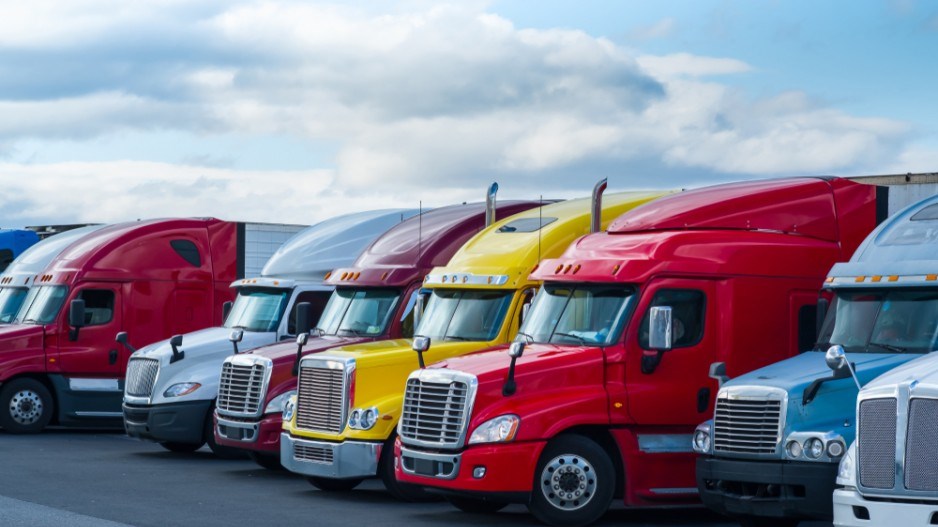The Port of Vancouver has again delayed the start date of a program aimed at replacing older trucks in the drayage fleet that services port terminals, but a group of independent operators remains unhappy – and is again threatening job action.
The Vancouver Fraser Port Authority said the Rolling Truck Age Program, designed to retire trucks older than 12 model years from the port’s drayage fleet, will now start in April 2023. The program, designed to remove older, more polluting vehicles from port operations, had been set to start last February. It was later delayed to September 15 prior to the latest announcement.
Greg Rogge, director of land operations and security at Vancouver Fraser Port Authority, said the port reached the decision to push the start date to April 2023 after consultation with Transport Canada and the office of federal Transport Minister Omar Alghabra.
“They are hearing concerns still from some of the constituents about the availability of replacement trucks,” Rogge said. “Quite frankly, we are completely in disagreement with that. We know because we follow the marketplace, and we know there are a lot of trucks that are available.”
The United Truckers Association (UTA) – a group of independent owner-operators of container trucks that service the port – said the Rolling Truck Age Program unfairly targets them, forcing them to carry the costs of buying a newer, more energy-efficient vehicle at a time when no other commercial trucking community in the province is required to buy new trucks.
The UTA had said in July it has voted 639-0 to authorize job action against the port in protest, but also noted at the time that the group is delaying any escalation to accommodate “potential negotiations” with the port authority. In a statement issued this week, the UTA said the latest announcement has pushed the group one step closer to taking labour action.
“The United Truckers Association is treating the recent Port of Vancouver Rolling Truck Age Program deferral as an inflammatory announcement that has the potential to permanently destabilize the Metro Vancouver drayage sector,” the statement said. “While the UTA is happy with the intervention of Minister Omar Alghabra and Members of Parliament Randeep Sarai and Taleeb Noormohamed, there are a number of inflammatory factors with the potential to act as a powder keg ...”
The central point of contention despite the delay of the program, said UTA spokesman Gagan Singh, is that while the implementation date is deferred, the port is now also requiring drivers to upgrade to a truck from model year 2016 or newer – only a seven-model-year allowance for trucks eligible to operate at the port (versus the 12-model-year limit as indicated by the Rolling Truck Age Program).
“Instead of providing time for compliance as is being claimed, the newer and more punitive standard of truck age is forcing [independent operators] into further cost and marketplace difficulty,” Singh said.
Rogge, however, noted that the UTA may have mixed up another separate program – the port’s truck entrant requirements – with the Rolling Truck Age Program. He noted that the truck entrant requirements determine if a new owner-operator can bring his or her truck into the drayage fleet for the first time, and the program has already been in place since 2011.
Back then, a new owner-operator was required to have a 2007 truck or newer. That requirement was then updated in 2015 to trucks newer than 2010, in 2019 to trucks newer than 2014 and again on Jan. 1, 2023, to trucks 2016 or newer.
The requirement does not apply to owner-operators already in the drayage fleet, meaning that there were operators with trucks more than two decades old prior to recent modernization efforts. The Rolling Truck Age Program, in turn, is one of those efforts aimed at trucks already in the drayage fleet, Rogge said.
“It means that, if they bought a 2014 truck now – which doesn’t make a lot of sense to me because you are still buying a nine-year-old truck with a 12-year limit in the Rolling Truck Age Program – a driver still has the opportunity to do that if they choose to until Jan. 1, 2023,” Rogge noted. “The truck entrant requirements have been around for well over a decade. We put it in our consideration memo after consultation with the industry in May and June this year, and we put out a reminder again earlier this week.
“In no way, shape or form are we saying that – if you already have a truck in the fleet – that you couldn’t continue to drive [if it fits the Rolling Truck Age Program’s 12-model-year requirement].”
The UTA maintains that the cost pressures on truckers are the same, adding that it is “extending one last plea for Minister Alghabra to take control of this file before labour action with the potential to cause billions of dollars in negative impact occurs.”
The port authority, however, also reiterated that more than 80 per cent of the drayage truck fleet at the Port of Vancouver is already compliant with the Rolling Truck Age Program’s 12-model-year requirements.
“We are in this for the long game, providing one last six-month delay for the last cohorts to get out there and replace their trucks,” Rogge said. “... A lot of trucker operators have already invested. The BC Trucking Association is very supportive; the program is supported by municipal community groups, the Vancouver Park Board, and so on. It supports the federal government’s emission reduction strategy target of 40 per cent below 2005 levels by 2030.
“The stakes are very high for communities here. Old trucks are major emitters of particulate matter, which is a cancer-causing agent... The [Rolling Truck Age Program] is the right thing to do when it removes an estimated 93 per cent of particulate matter that’s caused by the drayage fleet, which performs 30,000 to 40,000 trips a week.”




